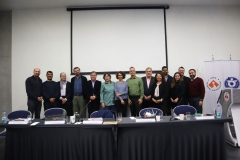
FACULTY OF BUSINESS
Department of Political Science and International Relations
CDM 101 | Course Introduction and Application Information
| Course Name |
Images, Sounds, Cultures I
|
|
Code
|
Semester
|
Theory
(hour/week) |
Application/Lab
(hour/week) |
Local Credits
|
ECTS
|
|
CDM 101
|
Fall/Spring
|
2
|
2
|
3
|
6
|
| Prerequisites |
None
|
|||||
| Course Language |
English
|
|||||
| Course Type |
Service Course
|
|||||
| Course Level |
First Cycle
|
|||||
| Mode of Delivery | - | |||||
| Teaching Methods and Techniques of the Course | DiscussionQ&ALecture / Presentation | |||||
| Course Coordinator | - | |||||
| Course Lecturer(s) | ||||||
| Assistant(s) | - | |||||
| Course Objectives | This course aims to change the way students look at the visual world that surrounds them. It will help students to develop an understanding of the ways in which meaning is produced in visual culture. The course will center on the following questions: How do we make meaning of the audio-visual world? In what ways do economics, politics, culture affect visual representation? How do the ways in which visual culture is produced, consumed, distributed, and interpreted, play into the images we encounter every day? What is the relationship between images and power? |
| Learning Outcomes |
The students who succeeded in this course;
|
| Course Description | The course reviews images ranging from newspapers to the Web, advertisements to the movies, from television to fine arts and discusses cultural products in their economic, social, political and cultural contexts. The course will be held in interactive lecture form. Students are expected to participate in class discussion. There will be in-class screening of videos related to the topics covered. Evaluation will be based on four take-home assignments. |
|
|
Core Courses | |
| Major Area Courses | ||
| Supportive Courses | ||
| Media and Management Skills Courses | ||
| Transferable Skill Courses |
WEEKLY SUBJECTS AND RELATED PREPARATION STUDIES
| Week | Subjects | Related Preparation |
| 1 | Introduction. Basic concepts | Marita Sturken & Lisa Cartwright. 2009. Practices of looking: an introduction to visual culture. New York: Oxford University Press. Pp. 9-16. |
| 2 | What is visual culture? Images, power, politics. Screening Episode 1, Ways of Seeing, John Berger (BBC TV series, 1972) https://www.youtube.com/watch?v=0pDE4VX_9Kk | John Berger, Ways of Seeing, Penguin, 1972. Pp. 7-33 (Chapter 1). Michel Foucault “Las Meninas” Chapter 1 in The Order of Things: An Archeology of Human Sciences (Les Mots et les choses) pp. 3-16. |
| 3 | What is representation? Representation and the Media Screening: Stuart Hall, Representation and the Media (MEF, 1997) | Stuart Hall (Ed) 1997. Representation. Cultural Representations and Signifying Practices. Sage Publications. Marita Sturken & Lisa Cartwright. 2009. Practices of looking: an introduction to visual culture. New York: Oxford University Press. Pp. 16-22. |
| 4 | Ways of Seeing, Practices of Looking Renaissance perspective and other ways of seeing Screening A Day on the Grand Canal With the Emperor of China. “Surface is Illusion, But so is Depth.” 1988. Director: Philip Haas. Writernarrator: David Hockney Art, Aura, Authenticity Assignment 1 (Representation) due | Marita Sturken & Lisa Cartwright. 2009. Practices of looking: an introduction to visual culture. New York: Oxford University Press. Pp. 151-157. Walter Benjamin (1936) “The Work of Art in the Age of Mechanical Reproduction” in Illuminations. Pp. 211-244. |
| 5 | Semiotics | Roland Barthes (1977) “Rhetoric of the image” Image - Music - Text. Hill and Wang, pp.32-51. |
| 6 | Mythologies | Roland Barthes “The Eiffel Tower” in The Eiffel Tower and Other Mythologies. University of California Press. pp. 3-17 |
| 7 | Stereotypes Ideology Screening Reel Bad Arabs (MEF, 2006) | Marita Sturken & Lisa Cartwright. 2009. Practices of looking: an introduction to visual culture. New York: Oxford University Press. pp. 22-26. |
| 8 | Orientalism Screening Edward Said on Orientalism (MEF, 1998) https://www.youtube.com/watch?v=fVC8EYd_Z_g Assignment 2 (Stereotypes) due | Edward Said. 1977. “Imaginative geography and the its representations: Orientalizing the Oriental” in Orientalism. Western Conceptions of the Orient. Penguin Books. Pp. 49-72. |
| 9 | Culture Culture Industry Screening Money for Nothing (MEF, 2001) | Raymond Williams. 1976. “Culture” in Keywords, Oxford University Press. pp. 87-93. Theodor Adorno & Max Horkheimer. “The Culture Industry. Enlightenment as mass deception” in Gunzelin Schmid Noerr (Ed). 2009. Dialectic of enlightenment: philosophical fragments. Stanford Univ. Press. Pp. 41-72. |
| 10 | Identity Otherness Assignment 3 (Culture Industry) due | Bell Hooks (2015) “eating the other. desire and resistance” in Black Looks. Race and Representation. Routledge. Pp. 21-40. |
| 11 | Gender Codes Screenings Codes of Gender (MEF, 2010) Episode 2, Ways of Seeing, John Berger (BBC TV series, 1972) https://www.youtube.com/watch?v=m1GI8mNU5Sg | John Berger “Chapter 2” in Ways of Seeing. 1972. |
| 12 | Identification Assignment 4 (Gender Codes) due | Review Interactive Exhibition on MoMA website: https://www.moma.org/interactives/exhibitions/2012/cindys herman/gallery/2/mobile.php |
| 13 | Viewers Make Meaning | Marita Sturken & Lisa Cartwright. 2009. Practices of looking: an introduction to visual culture. New York: Oxford University Press. Pp. 49-91. |
| 14 | Overview | |
| 15 | Review of the semester | |
| 16 | Review of the semester |
| Course Notes/Textbooks | |
| Suggested Readings/Materials | Marita Sturken & Lisa Cartwright. 2009. Practices of looking: an introduction to visual culture. New York: Oxford University Press. |
EVALUATION SYSTEM
| Semester Activities | Number | Weigthing |
| Participation |
1
|
20
|
| Laboratory / Application | ||
| Field Work | ||
| Quizzes / Studio Critiques | ||
| Portfolio | ||
| Homework / Assignments |
1
|
20
|
| Presentation / Jury | ||
| Project |
3
|
60
|
| Seminar / Workshop | ||
| Oral Exams | ||
| Midterm | ||
| Final Exam | ||
| Total |
| Weighting of Semester Activities on the Final Grade |
5
|
100
|
| Weighting of End-of-Semester Activities on the Final Grade | ||
| Total |
ECTS / WORKLOAD TABLE
| Semester Activities | Number | Duration (Hours) | Workload |
|---|---|---|---|
| Theoretical Course Hours (Including exam week: 16 x total hours) |
16
|
2
|
32
|
| Laboratory / Application Hours (Including exam week: '.16.' x total hours) |
16
|
2
|
32
|
| Study Hours Out of Class |
16
|
4
|
64
|
| Field Work |
0
|
||
| Quizzes / Studio Critiques |
0
|
||
| Portfolio |
0
|
||
| Homework / Assignments |
1
|
20
|
20
|
| Presentation / Jury |
0
|
||
| Project |
3
|
10
|
30
|
| Seminar / Workshop |
0
|
||
| Oral Exam |
0
|
||
| Midterms |
16
|
0
|
|
| Final Exam |
0
|
||
| Total |
178
|
COURSE LEARNING OUTCOMES AND PROGRAM QUALIFICATIONS RELATIONSHIP
|
#
|
Program Competencies/Outcomes |
* Contribution Level
|
||||
|
1
|
2
|
3
|
4
|
5
|
||
| 1 | To be able to use the theoretical and practical knowledge acquired in the areas of Political Science and International Relations. |
|||||
| 2 | To be able to have the basic knowledge of, and make use of other disciplines which contribute to the areas of Political Science and International Relations. |
|||||
| 3 | To be able to distinguish the differences between classical and contemporary theories and to assess their relationship. |
|||||
| 4 | To be able to recognize regional and global issues, and develop solutions based on research. |
|||||
| 5 | To be able to assess the acquired knowledge and skills in the areas of Political Science and International Relations critically. |
|||||
| 6 | To be able to transfer ideas and proposals on issues in the areas of Political Science and International Relations to other people and institutions verbally and in writing. |
|||||
| 7 | To be able to identify the historical continuity and changes observed in the relations between the actors and institutions of national and international politics. |
|||||
| 8 | To be able to examine concepts, theories, and developments with scientific methods in the areas of Political Science and International Relations. |
|||||
| 9 | To be able to take responsibility as an individual and as a team member. |
|||||
| 10 | To be able to act in accordance with the scientific and ethical values in studies related to Political Science and International Relations. |
|||||
| 11 | To be able to collect data in the areas of Political Science and International Relations and communicate with colleagues in a foreign language ("European Language Portfolio Global Scale", Level B1). |
|||||
| 12 | To be able to speak a second foreign at a medium level of fluency efficiently. |
|||||
| 13 | To be able to relate the knowledge accumulated throughout human history to their field of experience. |
|||||
*1 Lowest, 2 Low, 3 Average, 4 High, 5 Highest
NEWS |ALL NEWS
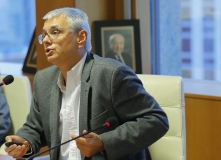
Sıtkı Egeli participated as a guest speaker at the HCOC Seminar
Faculty member of IUE Political Science and International Relations, Assoc. Prof. Dr. Sıtkı Egeli participated as a guest speaker at the HCOC
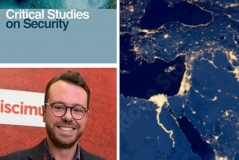
Umut Can Adısönmez's New Article Published in the Journal "Critical Studies on Security"
Faculty member of IUE Political Science and International Relations, Dr. Umut Can Adısönmez and Assoc. Prof. Laçin İdil Öztığ from Yıldız Technical
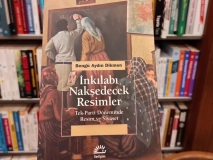
Dr. Bengü Aydın Dikmen's new book "İnkılabı Nakşedecek Resimler" is published!
Bengü Aydın Dikmen focuses on the painting policy during the foundation and construction period of the Republic. In this way, she also
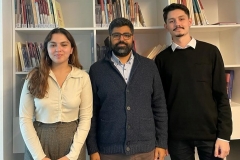
Serhun Al and Umut Can Adısönmez Lectured on Conflict Resolution and Peace Building
Faculty member of IUE Political Science and International Relations, Dr. Serhun Al and Dr. Umut Can Adısönmez, participated as trainers in the
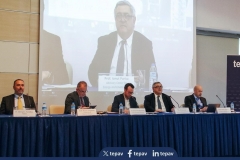
Umut Can Adısönmez participated in the "Human Security and Resilience in South East Europe" Panel
Faculty member of IUE Political Science and International Relations, Dr. Umut Can Adısönmez participated in the panel discussion "Human Security and Resilience
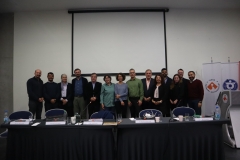
We Organized Our Republican Centennial Symposium
As the IUE Political Science and International Relations Department, we organized a symposium on the Centennial of our republic. In the symposium
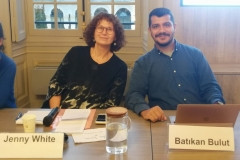
Batıkan Bulut presented his proceeding on the CEST 2023 Paris Symposium
Research assistant of the IUE Department of Political Science and International Relations, Batıkan Bulut presented his paper titled "Civil Society and Competitive



